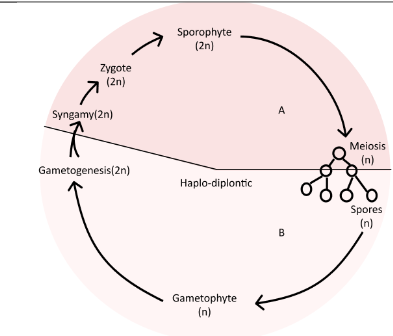Step-by-Step Solutions For Class 11 Biology Chapter 3 In Hindi - Free PDF Download
FAQs on NCERT Solutions For Class 11 Biology Chapter 3 Plant Kingdom in Hindi - 2025-26
1. Where can I find accurate and complete NCERT Solutions for Class 11 Biology Chapter 3, Plant Kingdom?
You can find comprehensive and expert-verified NCERT Solutions for Class 11 Biology Chapter 3 (Plant Kingdom) on Vedantu. These solutions are fully aligned with the CBSE 2025-26 syllabus and provide detailed, step-by-step answers for every question in the NCERT textbook exercise, ensuring you understand the correct methodology for exams.
2. What is the correct step-by-step method to answer the NCERT question comparing the life cycles of mosses and ferns?
To correctly answer a comparison question on the life cycles of a moss (bryophyte) and a fern (pteridophyte) as per the NCERT pattern, follow these steps:
- Start by identifying the dominant phase in each: the gametophyte (n) in mosses and the sporophyte (2n) in ferns.
- Use a tabular format to clearly contrast key features like the main plant body, presence of vascular tissues (xylem and phloem), and the dependency of the sporophyte and gametophyte.
- Draw simple, labelled diagrams for both life cycles to illustrate the alternation of generations.
- Conclude by highlighting the evolutionary advancement of ferns over mosses, such as having a dominant sporophyte and a vascular system.
3. How do the Vedantu NCERT Solutions explain the concept of alternation of generations with examples from the Plant Kingdom?
Vedantu's NCERT Solutions explain the alternation of generations by breaking down the life cycle of a plant into its two distinct phases: the haploid gametophyte (produces gametes) and the diploid sporophyte (produces spores). The solutions use specific examples from the chapter to clarify how the dominance of these phases changes across different plant groups, such as the gametophyte-dominant phase in bryophytes versus the sporophyte-dominant phase in pteridophytes, gymnosperms, and angiosperms.
4. Why is it crucial to use tabular columns when answering NCERT questions that ask for differences between Gymnosperms and Angiosperms?
Using a tabular column is a highly effective answering strategy because it presents a direct, point-by-point comparison that is clear and easy for examiners to evaluate. For a question on Gymnosperms vs. Angiosperms, this method allows you to precisely contrast fundamental differences, such as:
- The nature of ovules (naked in Gymnosperms vs. enclosed in an ovary in Angiosperms).
- The presence of fruit (absent in Gymnosperms, present in Angiosperms).
- The complexity of vascular tissues.
- The process of fertilization, highlighting double fertilisation as a unique feature of Angiosperms.
5. How do the NCERT solutions for Chapter 3 help in correctly answering questions on the economic importance of Algae and Bryophytes?
The NCERT solutions guide you to structure your answer methodically. They show you how to categorise the economic importance under clear headings like 'Commercial Uses', 'Food Sources', and 'Ecological Roles'. The solutions emphasize quoting specific examples as mentioned in the NCERT textbook, such as using Agar from Gelidium and Gracilaria (algae) or the use of Sphagnum (a moss) as peat/fuel. This method ensures your answer is comprehensive, accurate, and aligned with CBSE evaluation criteria.
6. What is a common mistake when solving questions about haplontic, diplontic, and haplo-diplontic life cycles, and how do NCERT solutions help avoid it?
A common mistake is incorrectly identifying the dominant phase of the life cycle for a given plant group. For example, confusing the haplontic cycle of algae like Volvox with the haplo-diplontic cycle of bryophytes. NCERT solutions help prevent this by providing clear definitions and visual aids like flowcharts or diagrams for each cycle type. They explicitly map each major plant group to its characteristic life cycle (e.g., Fucus - diplontic, Ectocarpus - haplo-diplontic), which reinforces the concept and minimises confusion during exams.
7. How are the solutions for the Plant Kingdom chapter aligned with the latest CBSE syllabus for the 2025-26 session?
The NCERT Solutions for Class 11 Biology Chapter 3 are meticulously updated to be 100% compliant with the latest CBSE syllabus for the 2025-26 academic year. They address every question from the most recent edition of the NCERT textbook, focusing on the prescribed topics of Algae, Bryophytes, Pteridophytes, Gymnosperms, and Angiosperms, including their characteristic features and life cycles. This ensures that you are preparing with material that is currently relevant for your examinations.



























